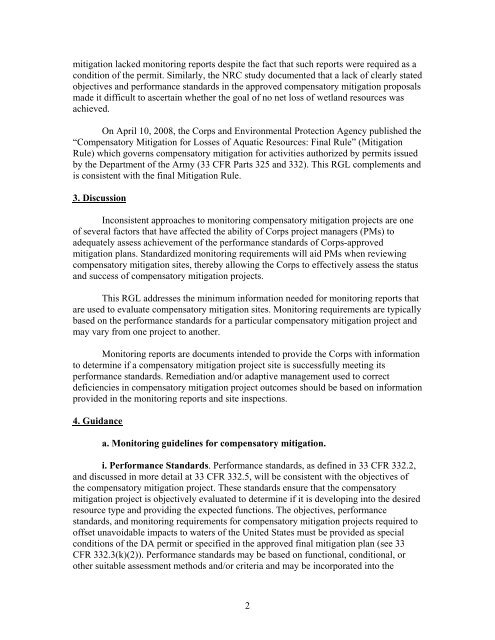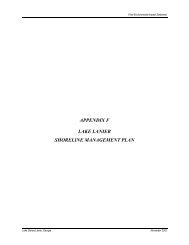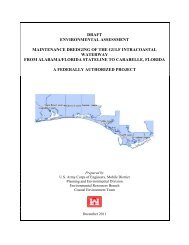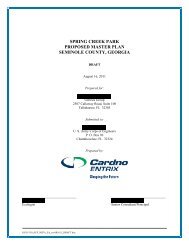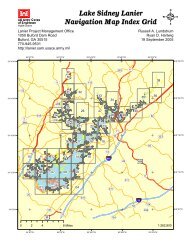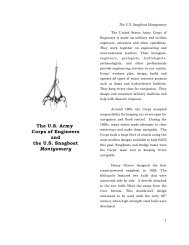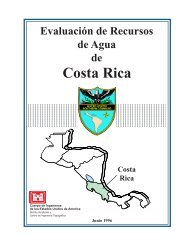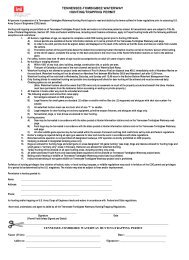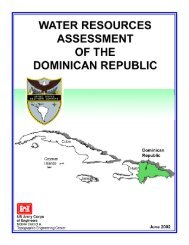REGULATORY GUIDANCE LETTER - U.S. Army
REGULATORY GUIDANCE LETTER - U.S. Army
REGULATORY GUIDANCE LETTER - U.S. Army
Create successful ePaper yourself
Turn your PDF publications into a flip-book with our unique Google optimized e-Paper software.
mitigation lacked monitoring reports despite the fact that such reports were required as a<br />
condition of the permit. Similarly, the NRC study documented that a lack of clearly stated<br />
objectives and performance standards in the approved compensatory mitigation proposals<br />
made it difficult to ascertain whether the goal of no net loss of wetland resources was<br />
achieved.<br />
On April 10, 2008, the Corps and Environmental Protection Agency published the<br />
“Compensatory Mitigation for Losses of Aquatic Resources: Final Rule” (Mitigation<br />
Rule) which governs compensatory mitigation for activities authorized by permits issued<br />
by the Department of the <strong>Army</strong> (33 CFR Parts 325 and 332). This RGL complements and<br />
is consistent with the final Mitigation Rule.<br />
3. Discussion<br />
Inconsistent approaches to monitoring compensatory mitigation projects are one<br />
of several factors that have affected the ability of Corps project managers (PMs) to<br />
adequately assess achievement of the performance standards of Corps-approved<br />
mitigation plans. Standardized monitoring requirements will aid PMs when reviewing<br />
compensatory mitigation sites, thereby allowing the Corps to effectively assess the status<br />
and success of compensatory mitigation projects.<br />
This RGL addresses the minimum information needed for monitoring reports that<br />
are used to evaluate compensatory mitigation sites. Monitoring requirements are typically<br />
based on the performance standards for a particular compensatory mitigation project and<br />
may vary from one project to another.<br />
Monitoring reports are documents intended to provide the Corps with information<br />
to determine if a compensatory mitigation project site is successfully meeting its<br />
performance standards. Remediation and/or adaptive management used to correct<br />
deficiencies in compensatory mitigation project outcomes should be based on information<br />
provided in the monitoring reports and site inspections.<br />
4. Guidance<br />
a. Monitoring guidelines for compensatory mitigation.<br />
i. Performance Standards. Performance standards, as defined in 33 CFR 332.2,<br />
and discussed in more detail at 33 CFR 332.5, will be consistent with the objectives of<br />
the compensatory mitigation project. These standards ensure that the compensatory<br />
mitigation project is objectively evaluated to determine if it is developing into the desired<br />
resource type and providing the expected functions. The objectives, performance<br />
standards, and monitoring requirements for compensatory mitigation projects required to<br />
offset unavoidable impacts to waters of the United States must be provided as special<br />
conditions of the DA permit or specified in the approved final mitigation plan (see 33<br />
CFR 332.3(k)(2)). Performance standards may be based on functional, conditional, or<br />
other suitable assessment methods and/or criteria and may be incorporated into the<br />
2


